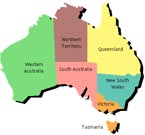Weather hot, wet and wild makes Australia what it is
 Sydney - In Australian poet Dorothea Mackellar's famous homage to her "willful, lavish land," she extols a weather trifecta of "floods and fire and famine" that "pays us back threefold."
Sydney - In Australian poet Dorothea Mackellar's famous homage to her "willful, lavish land," she extols a weather trifecta of "floods and fire and famine" that "pays us back threefold."
Cattle ranchers in the east-coast state of Queensland, 60 per cent of which is now flooded, are indeed looking for a tripling in earnings after the biggest downpours in decades have provided enough water to grow enough grass for two years of feed for their livestock.
AACo, the nation's biggest beef producer, has reported a "complete reversal" in its 2009 projections with profits from the greening of the land after three weeks of rains overwhelming losses from recent droughts.
The turnaround is evident in the stock market. The more it rains, the higher AACo's share price goes.
"All our Barkly properties that suffered from dry conditions last year have probably received in the last couple of weeks the amount of rain they got in all of last year," said AACo chief executive Stephen Toms.
Some of those properties received more rain in a 24-hour period than they did in the previous 18 months. Toms said the drought-breaking rains would reinforce Australia's position as the world's second-biggest beef exporter after Brazil.
The volume of water is mind-boggling with more than 1 million square kilometres under water.
The Cloncurry River went from a trickle to a height of 7 metres in a week. Normanton, normally a dusty cattle town of 1,600 people, is now engulfed in floodwaters as far as the eye can see.
Rick Britton, the mayor of the 61,000-square-kilometre Boulia Shire, said the big wet had bucked up farmers.
"She's God's country," he told The Australian newspaper. "An inch of rain on this country, and here, you get a response. I've lived here all my life, and it still amazes me what it can do for you."
Not that there aren't losses as well. Hundreds of houses and barns have been inundated, farm machinery is waterlogged and tens of thousands of cattle stranded by the floods are likely to die.
But in Outback Australia, the most precious commodity is water, and to-the-brim reservoirs are what sets farmers' hearts racing.
Many of the cattle facing a lingering death are animals weakened by the drought-induced famine that came before the flood. Getting feed to them - even finding out where they are - is too big a task when roads are under water and the savannah has been turned to marsh.
Using helicopters to drop feed to groups of animals is impractical.
Department of Primary Industries spokesman Tony Rayner said the instant switch from drought to deluge is what farmers have to contend with.
"We have a mixed situation in Queensland at the moment, where approximately 60 per cent of the state is disaster-declared," he said. "Whilst some of that 60 per cent is also declared under a drought declaration, it's easy to move from a drought situation to a disaster situation when you get record flooding and rain."
Farmers are getting government handouts for being in drought and government handouts for being in flood. Some are bankable again precisely because their patch of dirt is below muddy water.
The end of the drought in the north-east corner comes as feed grain prices are falling, fuel prices are falling and the fall in the value of the Australian dollar is helping exports. Also helping is an interest rate at a 40-year low of 3.25 per cent.
Mackellar was homesick and in London when she wrote My Country. Her wistful remembrance of the "drumming of an army/the steady soaking rain" that brings a "filmy veil of greenness/that thickens as we gaze" are as evocative now as they were in 1906. (dpa)